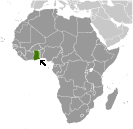World Atlas: Ghana. On this page you can see the map, country flag and many detailed information about the people, history and economy of Ghana.

Here you can find online selected information about the geography, inhabitants, government, economy and history of Ghana. Included are selected statistics, an overview map and the detailed map of Ghana. But let's start with the flag of Ghana here:
Ghana - Overview:
What you should know about Ghana? Let's start with this: Formed from the merger of the British colony of the Gold Coast and the Togoland trust territory, Ghana in 1957 became the first sub-Saharan country in colonial Africa to gain its independence. Ghana endured a series of coups before Lt. Jerry Rawlings took power in 1981 and banned political parties. After approving a new constitution and restoring multiparty politics in 1992, Rawlings won presidential elections in 1992 and 1996 but was constitutionally prevented from running for a third term in 2000. John Kufuor of the opposition New Patriotic Party (NPP) succeeded him and was reelected in 2004. John Atta Mills of the National Democratic Congress won the 2008 presidential election and took over as head of state, but he died in July 2012 and was constitutionally succeeded by his vice president, John Dramani Mahama, who subsequently won the December 2012 presidential election. In 2016, however, Nana Addo Dankwa Akufo-addo of the NPP defeated Mahama, marking the third time that the Ghana’s presidency has changed parties since the return to democracy.
Geography of Ghana
 Where on the globe is Ghana? The location of this country is Western Africa, bordering the Gulf of Guinea, between Cote d'Ivoire and Togo. Total area of Ghana is 238,533 sq km, of which 227,533 sq km is land. So this is quite a large country. How could we describe the terrain of the country? This way: mostly low plains with dissected plateau in south-central area. The lowest point of Ghana is Atlantic Ocean 0 m, the highest point Mount Afadjato 885 m. And the climate is tropical; warm and comparatively dry along southeast coast; hot and humid in southwest; hot and dry in north.
Where on the globe is Ghana? The location of this country is Western Africa, bordering the Gulf of Guinea, between Cote d'Ivoire and Togo. Total area of Ghana is 238,533 sq km, of which 227,533 sq km is land. So this is quite a large country. How could we describe the terrain of the country? This way: mostly low plains with dissected plateau in south-central area. The lowest point of Ghana is Atlantic Ocean 0 m, the highest point Mount Afadjato 885 m. And the climate is tropical; warm and comparatively dry along southeast coast; hot and humid in southwest; hot and dry in north.
Inhabitants of Ghana
Let's take a look how many people live in Ghana. The number is: 27,499,924. So quite a lot people live here. Who lives here? Akan 47.5%, Mole-Dagbon 16.6%, Ewe 13.9%, Ga-Dangme 7.4%, Gurma 5.7%, Guan 3.7%, Grusi 2.5%, Mande 1.1%, other 1.4% (2010 est.). What are the languages in Ghana? Asante 16%, Ewe 14%, Fante 11.6%, Boron (Brong) 4.9%, Dagomba 4.4%, Dangme 4.2%, Dagarte (Dagaba) 3.9%, Kokomba 3.5%, Akyem 3.2%, Ga 3.1%, other 31.2%. And the religions: Christian 71.2% (Pentecostal/Charismatic 28.3%, Protestant 18.4%, Catholic 13.1%, other 11.4%), Muslim 17.6%, traditional 5.2%, other 0.8%, none 5.2% (2010 est.). How old are the people in average? 21.1 years. We have to add that this number is the median - so one half of the people is older than this, one half is younger. And what is their life expectancy (at birth)? This: 67 years. Where the people live in Ghana? Here: population is concentrated in the southern half of the country, with the highest concentrations being on or near the Atlantic coast. The major urban areas of Ghana are: Kumasi 2.599 million; Accra (capital) 2.277 million (2015).
Government and Economy of Ghana
The capital of Ghana is Accra and the government type presidential republic. Let's take a look at the administrative divisions - 10 regions; Ashanti, Brong-Ahafo, Central, Eastern, Greater Accra, Northern, Upper East, Upper West, Volta, Western. Regarding the economy of Ghana, important industrial products are mining, lumbering, light manufacturing, aluminum smelting, food processing, cement, small commercial ship building, petroleum. Important agricultural products are cocoa, rice, cassava (manioc, tapioca), peanuts, corn, shea nuts, bananas; timbe. The most important export commodities are oil, gold, cocoa, timber, tuna, bauxite, aluminum, manganese ore, diamonds, horticultural products and the most important export partners are Switzerland 17.6%, India 14.7%, UAE 13.4%, China 8.9%, Vietnam 5.2%, Netherlands 4.2%, Burkina Faso 4% (2016). The most important import commodities are capital equipment, refined petroleum, foodstuffs and the most important import partners are China 17.3%, UK 9.7%, US 7.7%, Belgium 5.1%, India 4.6% (2016). How rich is Ghana and how rich are people in this country? The most important number here is GDP per capita (PPP): $4,600 (2017 est.). This is a very low number. Let's add that this means Gross Domestic Product per person, which is recalculated with respect to the relative cost of local goods and services. And one more important number - population below poverty line: 24.2% (2013 est.).